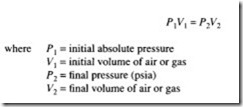CHARACTERISTICS OF COMPRESSED AIR
Pascal’s law states that the pressure of a gas or liquid exerts force equally in all directions against the walls of its container. The force is measured in terms of force per unit area (pounds per square inch-psi). This law is for liquids and gases at rest and neglects the weight of the gas or liquid. It should be noted that the field of fluid power is divided into two parts, pneumatics and hydraulics. These two have many character istics in common. The difference is that hydraulic systems use liquids and pneumatic systems use gases, usually air. Liquids are only slightly compressible and in hydraulic systems this property can often be neglected. Gases, however, are very compressible.
Three properties of gases must be well understood in order to gain an understanding of pneumatic power systems. These are its temperature, pressure, and volume. Com pressed air systems and compressors are governed by a number of physical laws that define their efficiency and system dynamics.
THERMODYNAMICS
Both the first and second laws of thermodynamics apply to all compressors and com pressed air systems.
First Law of Thermodynamics
This law states that energy cannot be created or destroyed during a process, such as compression and delivery of air or gas, although it may change from one form of energy to another. In other words, whenever a quantity of one kind of energy disap pears, an exactly equivalent total of other kinds of energy must be produced.
Second Law of Thermodynamics
This is more abstract and can be stated in several ways:
o Heat cannot, of itself, pass from a colder to a hotter body.
o Heat can be made to go from a body at lower temperature to one at higher temperature only if external work is done.
o The available energy of the isolated system decreases in all real processes.
o Like water, heat or energy will, of itself, flow only downhill.
Basically, these statements say that energy exists at various levels and is available for use only if it can move from a higher to a lower level. In thermodynamics a measure of the unavailability of energy has been devised and is known as entropy. It is defined by the differential equation
Entropy, as a measure of unavailability, increases as a system loses heat, but remains constant when there is no gain or loss of heat, as in an adiabatic process.
BOYLE’S LAW
If a fixed amount of gas is placed in a container of variable volume (such as a cylinder fitted with a piston), the gas will fill completely the entire volume, however large it may be. If the volume is changed, the pressure exerted by the gas will also change. As the volume decreases, the pressure increases. This property is called Boyle’s law and can be written as
According to Boyle’s law, the pressure of a gas is inversely proportional to the vol ume, if the temperature is held constant. For example, 2 cubic feet at 4 psi would exert only 1 psi if allowed to expand to 8 cubic feet.
In calculations that involve gas pressure and volume, absolute pressure, or pounds per square inch absolute (psia), must be used.
CHARLES’ LAW
If a fixed quantity of gas is held at a constant pressure and heated or cooled, its volume will change. According to Charles’ law, the volume of a gas at constant pressure is directly proportional to the absolute temperature. This is shown by the following equation:
It is important to remember that absolute temperature must be considered, not tem perature according to normal Fahrenheit or Celsius scales. The absolute Fahrenheit scale is called Rankin and the absolute Centigrade is called Kelvin. For conversion:
0″ Fahrenheit = 4,600 Rankin
0° Celsius= 2,730 Kelvin Thus, gas at 700oF would be 5,300 on the Rankin scale.
COMBINED EFFECT OF PRESSURE, VOLUME, AND TEMPERATURE
Pressure, temperature, and volume are properties of gases that are completely interre lated. Boyle’s law and Charles’ law may be combined into the following ideal gas law, which is true for any gas:
According to this law, if the three conditions of a gas are known in one situation, then if any condition is changed the effect on the others may be predicted.

